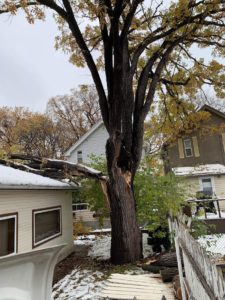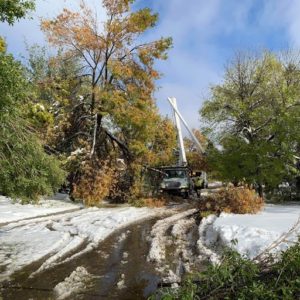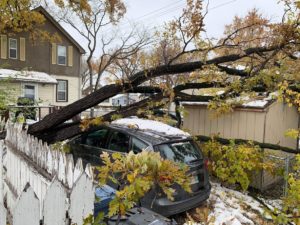As I write this, it is actually November 5 and has been snowing all day, with -17 in tonight’s forecast for a low. So, I guess this means it is finally winter now on the Prairies?
It is possible, even in Southern Alberta, where warm westerly Chinook winds provide us with intermittent reprieves from winter’s cold embrace, that winter may be here for a while now. This is not the first snow we’ve seen this season though. In early September, there was cold weather and a significant snow fall in Southern Alberta, where 100 cm fell in Waterton Lakes National Park, bringing about a swift end to the tree planting season there and the commencement of tree removal season. As thousands of trees burnt in the forest fire there a few years ago, they still need to be identified as hazard trees and removed safely, before they impact areas frequented by park visitors.
Elsewhere on the Prairies, it was a different story. In Northern Alberta, there was no early snow and summer hung on with a gentle ease into autumn.
In Winnipeg however, the worst early snowstorm that any arborist has ever seen dumped up to 75 cm of heavy, wet snow. The snow started falling on October 10th and hit really hard on the 11th. Reminiscent of the “Snowpocalypse” the City of Calgary experienced in “Snowtember” of 2014 that damaged or destroyed hundreds of thousands of trees, City officials in Winnipeg are still working on the damage estimate and have been extremely busy since the storm hit.
Martha Barwinsky, a city forester for Winnipeg was quoted on October 17 on CTV News estimating that up to 30,000 of the 300,000 trees in the city’s canopy may have been impacted. Urban forestry crews from the cities of Saskatoon, Calgary and Regina were sent to help with the disaster, in the true spirit of Canada.
 |
 |
 |
We are a nation that loves its trees, and as arborists and urban foresters, we are ready and willing to help when disaster strikes. Incidents like this one, along with the recent windstorm in Quebec and New Brunswick, as well as Hurricane Dorian in the Maritimes earlier this year, bring home the fact that severe damage to our cities’ green infrastructure could come at anytime, anywhere in Canada. Given the increased frequency of these severe weather events due to our current climate crisis, it is only further evidence that Canada needs a Red Seal trade for arborists to help with the mobility of qualified labour between provinces when these events happen.
Many thanks to Chris Barkman (The Barkman Professional Tree Care & Recreational Tree Climbing) and Rob Knight (Timberland Tree Service) in Winnipeg, and to Sam Heisler of the City of Saskatoon for the pictures.
Back to all articles